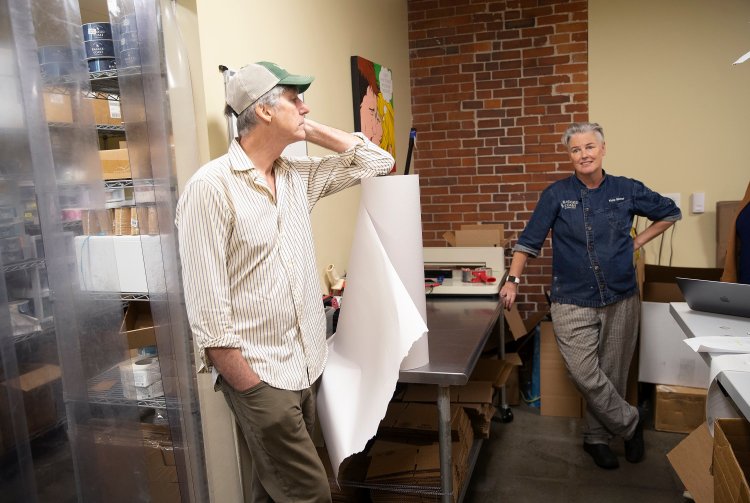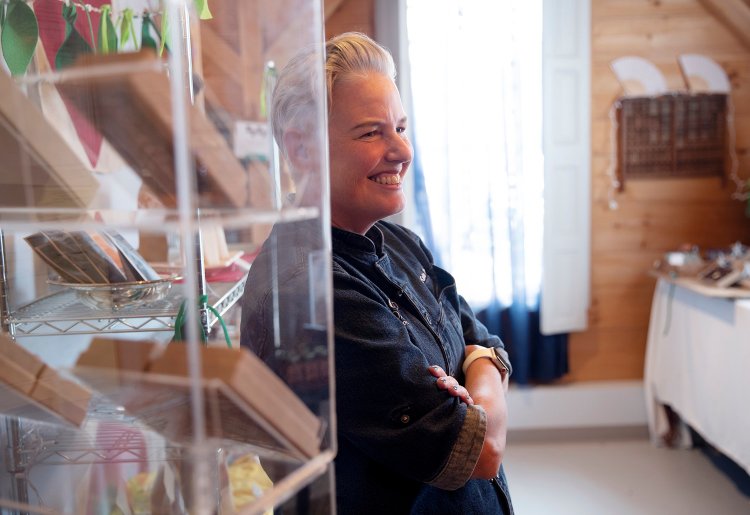

A lot of work goes into crafting beautiful, artisanal chocolates, like these from Ragged Coast Chocolates in Westbrook. As summers get hotter, local chocolate shops that mail-order must work harder than ever to ensure the chocolates arrive at their destinations without melting. Derek Davis/Staff Photographer
For some Maine industries – skiing, snowmobiling, fishing – climate change is an existential threat. For others, it’s impact is equally real, if less consequential. Put local chocolatiers in that second category. Longer, hotter summers are changing the way they must do business in small but time-consuming and costly ways.
“Chocolate and high temperatures really don’t get along!” as Allison Holt from Haven’s Candies in Westbrook and Portland neatly summed up the problem in an email. The bigger challenge for chocolatiers, it turns out, is not making the chocolate on the sort of sticky, sweaty days we’ve experienced this summer. It’s shipping the chocolate.
Like many of us, chocolate prefers low humidity and a nice, steady temperature of around 65 degrees F. (This is doubly true for fine chocolate, which lacks the stabilizers and preservatives of, say, your average Hershey bar.) That’s why, in the rooms where chocolates are crafted, the air-conditioning runs “24-7, 365 days a year,” said Colleen Osselaer, general manager of Harbor Candy Shop in Ogunquit. The problem comes once those gorgeous raspberry creme baskets, blueberry black pepper truffles, cherry cordials and such are nestled in a pretty box, tied up with a ribbon and sent on their way across the United States.
“Pretty much anything that goes out of store in hot weather you need to worry about,” said Kristin Thalheimer Bingham of Dean’s Sweets in Portland. “Chocolate can melt incredibly quickly. You get a little spot of sun on an 80-degree day, and it’s gone.”
And while warm weather has always been a consideration when shipping chocolate, or even sending a summer shopper out with a painstakingly selected assortment of bonbons, the time period that Maine chocolate shops must take “extreme pains,” as Kate Shaffer of Ragged Coast Chocolates in Westbrook phrased it, has grown. Warm-weather shipping used to mean “basically” July and August, she said. Though Ragged Coast has a small retail shop, most of its business is in e-commerce. Now, that season has more than doubled, she said, extending from May through September.
Hotter, less predictable weather brings a host of challenges to these often small, mom-and-pop shops, and while individually, the problems may seem as little as a chocolate truffle, added together, they can feel more like the Grande Sampler box.
Day to day, local chocolate shops find themselves expending more time and energy tracking the weather; devoting more of their often limited space to extra packaging materials, like gel packs, foil pouches and insulated boxes; giving over valuable freezer space to bulky boxed chocolates awaiting shipment; rethinking product lines; and spending more on all-important air-conditioning, to say nothing of extra packaging and mailing costs.
“YES! Climate change is a huge consideration for us,” Shaffer wrote in an email in response to a question about it.


Kate and Steve Shaffer of Ragged Coast Chocolates. Derek Davis/Staff Photographer
TRAFFIC CONTROL
Steve Shaffer, Kate’s husband, is the other half of Ragged Coast Chocolates, and while she makes the chocolates and manages the staff, “he deals with all the unfun stuff,” Kate Shaffer said, including shipping and deliveries. Seeing him in front of his computer, the screen open to National Oceanic and Atmospheric Administration (the site’s page front on Aug. 16 read, “Earth just had its warmest July on record”), and hearing him talk about the vicissitudes of shipping chocolate in a changing climate, feels a bit like being in the war room as generals debate a threat from Russia.
On a recent Wednesday, he was calculating how best to safely send out about 30 boxes of chocolate. Steve Shaffer needed to know the weather in Westbrook, of course, but equally the temperature at the destination of each box. He also had to factor in where the box could be stopping mid-route. Say a box of chocolate is being flown to Washington, D.C., the next day (predicted temperature, 88 degrees), he gave as an example. It would make a pit stop in Louisville, Kentucky (90 degrees), the southern air hub for UPS. “How do I insulate? How do I make sure it gets there? Or do I just say I can’t risk it?” he’d be asking himself.
Steve Shaffer also thinks about whether it’s cloudy out (good) or sunny (bad). He frets about the color of UPS delivery trucks. They’re brown, and darker colors absorb more heat. Then there’s the fact that delivery trucks have no ventilation or air-conditioning to keep their contents cooler. And once packages arrive at a processing center, that could well be broiling, too. (Yes, of course there are refrigerated trucks that deliver perishables. But those, chocolate shops say, are far too expensive to use.) Add to these concerns, the question of where a traveling box of chocolates could be stashed in a delivery truck.
“You’ve seen the cars that they use for USPS?” he said. “Somebody could have the thing sitting on their dashboard, sun beating down on it. It’s melting!”
Sometimes Steve Shaffer drives orders directly to the UPS facility in South Portland, “because I don’t want it sitting in the back of the truck for five hours after all the work that we’ve done.” If a gel pack lasts 24 hours, that’s five hours’ cooling power wasted before the package ever even leaves Greater Portland. It’s also important to ship in the early part of the week, because the last thing you want is a box of chocolates sitting somewhere – who knows where? And is it temperature-controlled? – over a potentially long, hot weekend.
Climate change also causes more volatile weather, be it hurricanes, floods or wildfires. And how those could affect delivery routes is anyone’s guess, Steve Shaffer said.
Even after chocolates reach their destination, there are no guarantees they can’t still become what Sarah Burns, co-owner of Chocolats Passion in Portland, described as “chocolate soup packages.”
“We try to make sure whoever is receiving it is aware of it, so it doesn’t sit on their porch,” Bingham said, “that they scoop it up as quickly as they can.”
SHIPPING DEPARTMENT
Beyond cool packs and insulated boxes (several shops have gone to double-insulated packaging), chocolate shops handle mail order in a variety of ways to mitigate the impact of sweltering days.
Chocolats Passion will only send to cooler destinations, a geographic range that’s updated weekly based on the weather map, “because it doesn’t matter how much ice you put in something going to Arizona right now,” Burns said, “it’s never going to last.”
Ragged Coast ships out all its products frozen (they won’t arrive that way). If the temperature is more than 85 degrees, customers outside of New England must select “next day air” for shipment, which is expensive. Shipping charges, several chocolate companies said, often are higher than the price of the chocolate. Otherwise, “We reserve the right to hold shipments until the weather cools down enough to ship your chocolate safely,” the Ragged Coast website says, which also urges customers to “Double and triple-check your shipping address.”
“I’m sorry, but if you live in Arizona or Texas, you are probably going to be waiting for that chocolate until September or October,” Kate Shaffer said.
An aside: Just what do fine chocolate shops in such brutally warm places do? In a telephone interview, a spokesperson for Araya Artisan Chocolate in Houston (temperature that day, 102 degrees F) outlined a set of concerns and procedures not dissimilar from those mentioned by Maine shops. “Just be proactive,” he advised his New England counterparts in short. “You can’t rely anymore on, ‘Hey I got an order. Let me just ship it.’ You’ve got to put a plan in place.”
Customers on the website of Dean’s Sweets must opt out of warm-weather shipping, which is the default setting. For those at the store, Dean’s Sweets will give out ice packs or hold purchased chocolates for the afternoon if the customer plans to be out and about in the hot sun.
At Harbor Candy Shop, shipping recommendations are made crystal clear. “Our recommendation is, if it’s 80 degrees or above, it should go next-day air; 70 to 79 degrees, second-day air,” Osselaer said. If customers ignore those recommendations and their chocolate arrives in a puddle, it’s on their shoulders, she said. Chocolate shops have a variety of policies about who covers the cost of chocolate if it melts in transit, so be sure to ask or read their websites carefully.
Harbor Candy also steers summertime shoppers toward sturdier candies. A section of its website devoted to “Easy Warm Weather Shipping” suggests about a dozen items including brittle, fudge, gummies, crystalized ginger and licorice.
None of these chocolatiers have opted for the more extreme solution of pausing mail-order for the summer.
“We want people to think about us year-round,” Steve Shaffer explained. “If they only think of us at the holidays, then (we) are out of mind. If I can’t send it (in summer), we’ve lost that customer.”
Nor have any of these shops switched to ice cream for the summer, a trend that Burns, at Chocolats Passion, said she’s noticed nationally on an online chocolate forum. And all of them thank their lucky stars that the major chocolate holidays – Halloween, Christmas, Valentine’s Day and Easter – come in Maine’s cooler months. Mother’s Day, Steve Shaffer said, can be a bit more problematic, occurring in the chocolate “shoulder season.”


Chocolate cake mix at Ragged Coast Chocolates in Westbrook. The company added cake mixes to its chocolate lineup in part to have a more heat-resistant product, as mailing products in increasingly hotter weather grows more challenging. Derek Davis/Staff Photographer
Ragged Coast Chocolates is adapting in other ways, though. It applied for, and got, a grant from the Maine Center for Entrepreneurs FoodTech program, which is working with the company to, among other things, find ways to mechanize the summer shipping process. The hope is to develop software, digital tools or package sensors to tell Ragged Coast exactly how best to wrap every outgoing box of chocolates.
It’s also adjusting its product line, in part because of climate change. The company now sells brownie, chocolate cake and scone mixes and, as of this month, three dessert sauces (rye whiskey caramel sauce, salted honey caramel sauce and dark chocolate hot fudge sauce) “that are not so affected by heat,” Kate Shaffer said.
THE BIG PICTURE
Which brings us to the elephant in the chocolate shop: Climate change is threatening the very life blood of chocolate production. Both sugar and cocoa – which is produced near the equator in Africa, Latin America and Indonesia – have soared in price this year, in large part because of droughts and other climate-related disasters.
As a result, Harbor Candy Shop is pulling its Taste of South America chocolate bars from its lineup. The price of the chocolate used to make the 4-ounce bars has gone up 42%, Osselaer said. If the store continued to produce them, she’d need to double their current sales price, from $8 a bar to $16, “so expensive that customers would never pay,” she said.
At Dean’s Sweets, Bingham shares her concern. “If we keep having these 20%, 40% increases in chocolate, we have no choice but to raise the prices and when is that going to stop?” she said. “At what point will our customer just say, ‘You know what? I can’t afford that or I don’t want to afford that.’ ”
Closer to home, Burns worries about the impact of climate change on local farms, from which the shop buys much of its accessory ingredients. “With the crazy weather and temperatures, family and small local farms are opting to close,” she said.
The store has always used strawberries from Maxwell’s Farm in Cape Elizabeth to make its strawberry-lemon chocolates and strawberry pâte de fruits. But this summer, the farm had a fruit fly infestation (attributed to warmer weather but not directly to climate change), and then abruptly closed down after more than 50 years. (The owners blamed “the challenges of farming in the current landscape.”) The chocolate shop also buys blueberries locally, and cream and butter regionally. It gets hazelnuts and pistachios from small family farmers on the West Coast.
“All of those are going to be affected from climate change, too,” Burns said.
Meanwhile, these chocolate shops are doing what they can to lessen their own environmental footprints. Several, including Dean’s Sweets, proudly touted switching from environmentally destructive Styrofoam packaging to recyclable boxes and cool packs.
“We did not want to add to the problem,” Bingham said. “We were adding to the problem in our first 10 years. We are making every effort to not be a part of the problem.”


Kate Shaffer of Ragged Coast Chocolates. Yes, climate change is a worry, but “It’s really hard to be a pessimist when you make chocolate for a living,” Derek Davis/Staff Photographer
Others are conscientiously buying chocolate from small producers that manage their cocoa orchards sustainably, get high scores on environmental “green” cards, and pay their workers a living wage.
“This is why we pay a premium for our cocoa, to support that,” Kate Shaffer said. “Maybe we are too late to reverse things, but let’s try to extend the life of our planet.”
She paused. “It’s really hard to be a pessimist when you make chocolate for a living,” she went on. “My whole work life is based on making people happy. It’s not going to help me if I give up to thinking the world is just doomed. I can’t go there.”
Copy the Story Link
Source link : http://www.bing.com/news/apiclick.aspx?ref=FexRss&aid=&tid=66cae5dcf1884476960eeb871a7b7d54&url=https%3A%2F%2Fwww.sunjournal.com%2F2024%2F08%2F25%2Fwhy-hotter-summers-are-causing-headaches-for-maine-chocolatiers%2F&c=12625987603911483907&mkt=en-us
Author :
Publish date : 2024-08-24 13:00:00
Copyright for syndicated content belongs to the linked Source.





